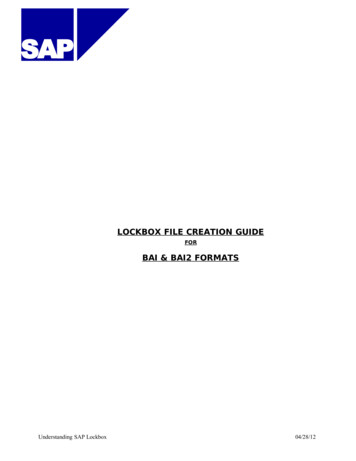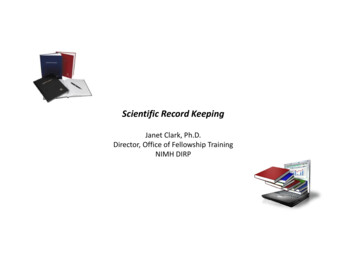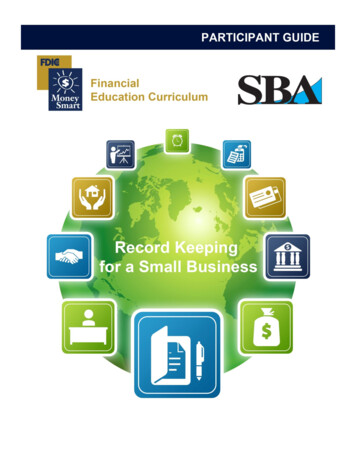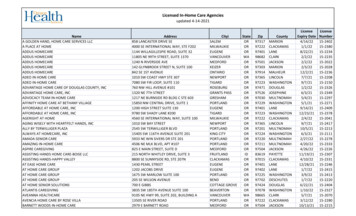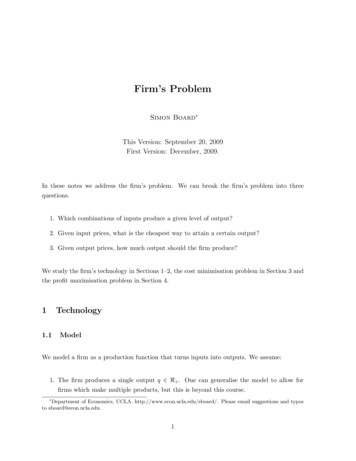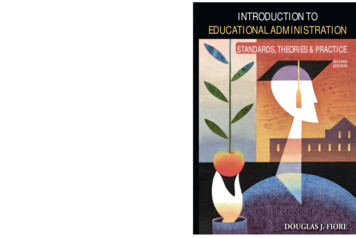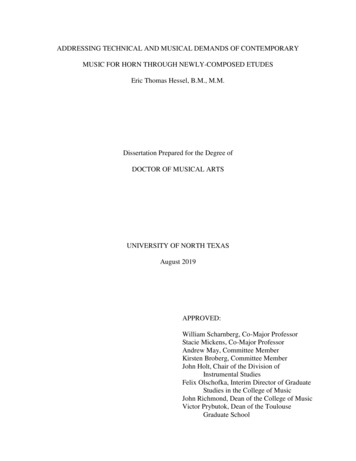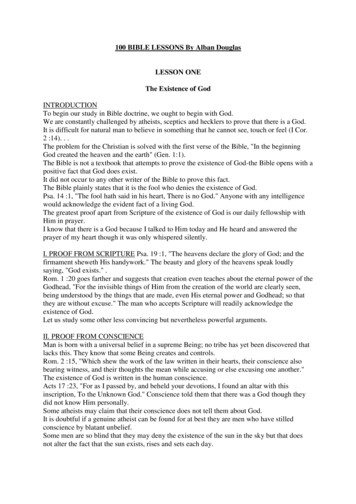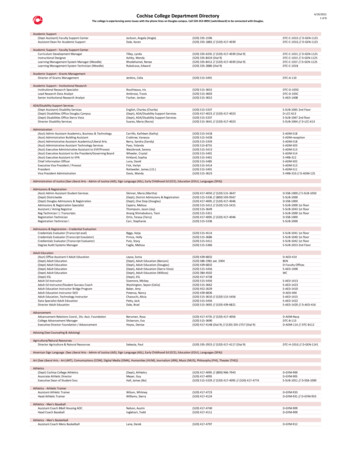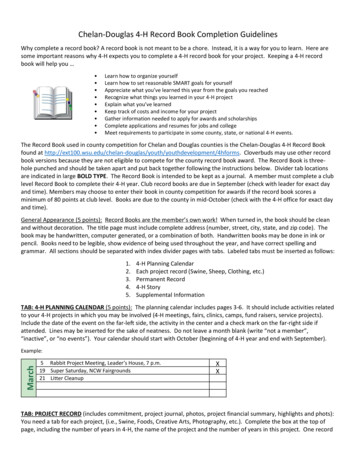
Transcription
Chelan-Douglas 4-H Record Book Completion GuidelinesWhy complete a record book? A record book is not meant to be a chore. Instead, it is a way for you to learn. Here aresome important reasons why 4-H expects you to complete a 4-H record book for your project. Keeping a 4-H recordbook will help you Learn how to organize yourselfLearn how to set reasonable SMART goals for yourselfAppreciate what you’ve learned this year from the goals you reachedRecognize what things you learned in your 4-H projectExplain what you’ve learnedKeep track of costs and income for your projectGather information needed to apply for awards and scholarshipsComplete applications and resumes for jobs and collegeMeet requirements to participate in some county, state, or national 4-H events.The Record Book used in county competition for Chelan and Douglas counties is the Chelan-Douglas 4-H Record Bookfound at velopment/4hforms. Cloverbuds may use other recordbook versions because they are not eligible to compete for the county record book award. The Record Book is threehole punched and should be taken apart and put back together following the instructions below. Divider tab locationsare indicated in large BOLD TYPE. The Record Book is intended to be kept as a journal. A member must complete a clublevel Record Book to complete their 4-H year. Club record books are due in September (check with leader for exact dayand time). Members may choose to enter their book in county competition for awards if the record book scores aminimum of 80 points at club level. Books are due to the county in mid-October (check with the 4-H office for exact dayand time).General Appearance (5 points): Record Books are the member’s own work! When turned in, the book should be cleanand without decoration. The title page must include complete address (number, street, city, state, and zip code). Thebook may be handwritten, computer generated, or a combination of both. Handwritten books may be done in ink orpencil. Books need to be legible, show evidence of being used throughout the year, and have correct spelling andgrammar. All sections should be separated with index divider pages with tabs. Labeled tabs must be inserted as follows:1.2.3.4.5.4-H Planning CalendarEach project record (Swine, Sheep, Clothing, etc.)Permanent Record4-H StorySupplemental InformationTAB: 4-H PLANNING CALENDAR (5 points): The planning calendar includes pages 3-6. It should include activities relatedto your 4-H projects in which you may be involved (4-H meetings, fairs, clinics, camps, fund raisers, service projects).Include the date of the event on the far-left side, the activity in the center and a check mark on the far-right side ifattended. Lines may be inserted for the sake of neatness. Do not leave a month blank (write “not a member”,“inactive”, or “no events”). Your calendar should start with October (beginning of 4-H year and end with September).MarchExample:5 Rabbit Project Meeting, Leader’s House, 7 p.m.19 Super Saturday, NCW Fairgrounds21 Litter CleanupXXTAB: PROJECT RECORD (includes commitment, project journal, photos, project financial summary, highlights and phots):You need a tab for each project, (i.e., Swine, Foods, Creative Arts, Photography, etc.). Complete the box at the top ofpage, including the number of years in 4-H, the name of the project and the number of years in this project. One record
is to be completed for each project. Additional copies of the Project Record are available online or at the ExtensionOffice. Members are encouraged to complete a project record for each project in which the member is enrolled,however, only one project record is required to complete the 4-H year.The Commitment (10 points): The commitment should be completed by the member early in the year and must includethe signatures of the member, the leader and the parent. This section basically outlines what you want to or will bedoing in your project this year. Goals may be determined as a club or on an individual basis. Goals need to be SMART(specific, measurable, attainable, realistic and timely). Cloverbuds and juniors should list at least 1 or 2 goals,intermediates should list 2 or more and seniors need at least 3 goals. Make sure all sections are filled out and signed.Part 1 –What I want to learn this year: List format may be used. Complete sentences are not necessary but may beused. Write your goals using the SMART technique:Specific-What do I want to accomplish or learn? Why is this goal important? Who is involved? Where will ithappen? Which resources will I need?Measurable- How much? How many? How will I know when it is accomplished?Attainable-How can I accomplish this goal? How realistic is the goal, (consider constraints such as money andtime?)Realistic-Is this goal worthwhile? Is this the right time? Do I have the correct resources?Timely-When? Goals need a target date, so you know what to work toward and where to focus your efforts.PROJECT RECORDYears in 4-H: 3Project: RabbitYears in this Project: 2This is what I want to learn/do/make this year:I want to learn 3 tips to properly care for my rabbit during the cold, before mid-November.I want to learn how to clip my rabbit’s toenails by myself by March. To learn about rabbit diseases/conditions such as sore hocks for my Demonstration in June.To make a schedule to work with each of my rabbits weekly to prepare for fitting and showing at the fair.Part 2-What my leader agrees to help me learn: This does not have to correspond with Part 1. Here you and your leadermust discuss what you need help with. A list form is acceptable. Complete sentences are not necessary. Youth writesthis, leader signs and dates.Part 3- How my parent agrees to help me learn: In this section you discuss how your parent will help (my parents agreeto pay for my project, take me to meetings, help me with my project by encouragement, etc.). Youth writes this, parentsigns and dates.Project Journal (20 points): The journal is a diary of activities which pertain to the project, plus a record of expenses.This is where you keep track of what you do in your project, how much it cost you to do it, the value, the time you spentand what you learned by doing it. It is very important that you describe what you did or learned with some amount ofdetail. An award-winning record book shows a lot of detail in the journal and regular dates showing you worked on yourproject. The journal should show what you are doing to support what you stated in your commitment. Some projectjournals especially those that deal with animals that have routine jobs (like feeding, riding grooming, etc.) may beentered/totaled on a monthly basis.
PROJECT JOURNALHow much?How many?DateWhat did you do or make?Jan. 1-31Feed and water rabbitsdaily.Jan. 10Purchased rabbit pellets.50 pounds1/20/16Clipped rabbit’s toenails.4 rabbitsCost4 rabbitsIncomeTime(hours)8.0 100.51.0Comments or what you learnedI need to check the water often to keep it fromfreezing. I spent approximately 15 minutes a dayfeeding and watering.4 rabbits eat a lot of pellets.My mini-rex does not like to be handled especiallywhen I touch her toes.The project journal includes:Date: This is a log of your actions. Keep it up to date.What did you do or make? List in order the things you did or made (purchased supplies, cooked dinner, taughtmy dog to heel).How much? /How Many? How much did you buy? How many people did you serve? How many did you make?If this column does not apply to what you did, leave it blank.Cost: What was the cost of the items you purchased? If you used feed or materials given to you by others,estimate the cost. For some things you do, there will be no cost.Income/Value: This is the amount you received for items sold or the estimated value of items you made orraised that were used at home. (If you sew a dress you can estimate the retail value as income, if you takepictures you can estimate the retail value of art for your room).Time: Estimate the time you spent on actions related to your project. For some activities you may want tosummarize weekly or monthly hours spent. Hours should be listed as whole numbers or decimals. Fifteenminutes is a quarter of an hour (0.25), thirty minutes is half an hour (0.5) and forty-five minutes is three quartersof an hour (0.75). Fifteen-minute increments are the smallest amount to be recorded.Comments or what you learned: Briefly tell what problems you had, things you learned and how you feel aboutwhat you made or did.Financial Summary (5 points): This is an important part of your records because it tells you how much your project costyou in time and money. Be sure to start with the inventory of all project supplies (animals, feed pans,brushes, etc.) when you began the 4-H year. The beginning values are to be completed at the beginning ofthe 4-H year (October 1st). Finish with the supplies, animals, etc. left at the end of the year. Ending valueis what you own at the end of the 4-H year (September 30th). Include all the income and expenses for your project usingthe project journal for reference. Be sure the math is correct.Example: PROJECT FINANCIAL SUMMARYBEGINNING VALUE (Materials, supplies, animals, equipment you had at the start of your project year.)DATE: 10/10/2015ItemRabbitsCagesWater bottles, feeders, grooming equipment, etc.Rabbit PelletsAmountValue4 100.002 doublesFor 4 rabbits25 pounds 200.00 65.00 5.00TOTALENDING VALUE (Materials, supplies, animals, equipment you had at the end of your project year.)DATE: 9/20/2016 370.00
ItemRabbitsCagesWater bottles, feeders, grooming equipment, etc.Rabbit PelletsAmount22 doublesFor 4 rabbits50 poundsValue 50.00 200.00 65.00 10.00TOTAL 325.001. Cost (project journal)2. Beginning Value Total (above)3. Total Cost (add lines 1 and 2)4. Income/Value (project journal)5. ending Value Total (above)6. Total Income/Value—add lines 4 and 57. Profit (loss)—subtract line 3 from line 68. Total time spent on project (project journal) 85.00 370.00 455.00 50.00 325.00 375.00- 80.00134 Hrs.Additional Project Records (no points): Some projects require additional or more information for complete records.Leadership record-CO898, Market Animal Health Records (Quality Assurance Forms) and Horse Certificates. Optionalrecords include garden plans, milk records, breeding records, livestock records, and additional health records. It isacceptable to include 4-H add sheets in your project record book after the financial summary page.Project Highlights (15 points): Refer back to your commitment and summarize what was done, any problems, yoursuccesses and accomplishments. Also include anything you would change for next time. Did you do what you set out todo? If you did, state how it turned out and how you feel about accomplishing the goals you set. If you didn’t do whatyou planned, tell why. Complete sentences or an outline are acceptable. This section is to be completed at the end ofthe year.Example: PROJECT HIGHLIGHTSWhat you learned. I learned that I need a heated water bottle, a protected area from the wind and a sturdy, warm hutch to keep myrabbit comfortable in the winter months. I learned that toenail clipping is very important and should be done about once a month. I learned that after working once a week for several months with my mini rex, he started to let me do things likeclip his toenails. I learned how to treat sore hocks by putting a board in the cage and using bag balm or Vaseline on the rabbit’shocks.Problems.I let my rabbit’s toenails get too long and he pulled it out in the carpet. If it doesn’t grow back, he will be disqualified fromshowing.Successes.My mini rex is much easier to handle now that I have been working with him.To do differently next time.I will make and follow a schedule to remember to clip toenails.Project Photos (5 points): Don’t forget to include photographs of you working with your project. Each photo should becaptioned and dated. These photos should only deal with this project, be of the current year and only one page. Donot add pages.
TAB: PERMANENT RECORD (20 points)- The Chelan/Douglas Permanent Record is a continuous diary of your 4-H relatedactivities throughout the years. This is the record that you carry year to year, book to book. Begin your permanentrecord as soon as you join 4-H. You may add pages as needed in the different sections.Offices/Committee Assignments: (page 1) List all offices, committees held whether club, county or state 4-Hrelated. List your responsibility. Committees could be barn decorations, phone, fund raising, etc.4-H Project and Exhibit Summary: (page 2-4) Place anything here that you show in a 4-H class with your project.(Non 4-H shows and contests is on page 15) List your projects by enrollment name. Show size by giving thenumber of garments made, animals raised or cared for, things canned, photos taken, etc. List what you exhibit(halter class, market class, breed class, conformation), where you exhibited and the award you received. It isrecommended you summarize by project and show location.Year14-1515-16ProjectRabbitRabbitSize1 rabbit4 rabbitsExhibitsBreed classBreed classWhereClubChelan CountyFairAwardNone3 blue, 1 red, 1Best of ClassJudging: (page 5) List all judging done, where you did it and award received. Do not forget the judging you do inyour local club. (Dog Judging, horse judging, livestock judging, clothing judging, etc.)Public Presentation: (page 6) List all demonstrations, illustrated talks and public speaking by title. Show whichproject the presentation involved. Put each separate demonstration on separate lines. All formal or informal 4H presentations given in the club, county contest or to a small group should be listed. Everyone must do a clubdemonstration to complete the 4-H year.Year15-16Presentation TitleA Doe, A Rabbit, AFemale RabbitProjectRabbitWhereChelan CountyDemo NightAwardBlue4-H Contest Entered: (page 7-8) Best described as a “person exhibit”. List areas in which the 4-H member’s skillsare being shown not the quality of the animal or garment. Examples: fitting and showing, fashion show,herdsmanship, record book, knowledge bowl, educational posters, equitation, etc.Year13-14ContestFitting and ShowingProjectRabbitWhereNCW Fair13-1413-14Educational PosterHerdsmanship –ClubRabbitRabbitNCW FairNCW FairAwardBlue, ReserveChampionBlue2nd PlaceEvents Attended: (page 9) List all the non-competitive 4-H events you attended. Example: Club clinics, awardprograms, clothing workshops, achievement night, Super Saturday, 4-H camps, etc. Do not include club orproject meetings. An event can be project related or general 4-H.Community Service: (page 10) List 4-H related community service projects. Example: Collected food for FoodBank, collected toys for TOTS, planted shrubs, picked up garbage, etc.4-H Promotion: (page 11) includes all the things in which you participated to promote 4-H. Example: news storywritten, community parade, introducing a new member to 4-H, wearing club shirt, etc.Leadership: (page 12-13) Record things you did to help others or teach others about 4-H projects. You do nothave to be enrolled in Leadership to help someone. Example: Helped new member with record books, helpedjunior member saddle horse, etc.
School and Community: (page 14) These are activities other than 4-H that you do. List your school activities,school awards, church activities, community activities that are not 4-H related.Non 4-H Contests Entered: (page 15) List non 4-H contests that are related to your 4-H projects. Example: Opengoat show, Wool Contest, ARBA rabbit show, etc.Most Important Recognition: (page 16) List the most important recognition you received in 4-H during the year,such as honors, awards, trips, etc. Blanks and not applicable responses are not acceptable in this section.Please reflect and find something to include.4-H Meeting Attendance: Any time your 4-H group gets together to do 4-H business, it is a club meeting. Recordthe number of club meetings you attended. Use one box for every year. If you belong to more than one club orgroup, total the meetings of both clubs and enter that total.TAB: 4-H STORY (10 points)- This should be written in complete sentences, paragraph form and tell the story of yourcurrent 4-H year. Think back on your 4-H year and reflect on what it has meant to you. What did you gain, how are youdifferent, what have you learned about yourself and your abilities because of your 4-H experience? Your story is asupplement to your project summaries. Do not simply repeat your project summaries. Additional pages may be added. Introduction- Introduce yourself. Include your age, your interests, your family, where you live, whereyou go to school, how long in 4-H, why you joined 4-H, etc. Project Experience – Write about each of the major projects/programs in which you are submitting arecord. If you mention your project highlights (do not focus on highlights, please do not repeat yourentire highlights page), instead explain what you have learned in the past year, why you chose theseprojects, interesting experiences, how your projects have grown in size and scope, things you tried andfound successful or unsuccessful, your financial profits/losses and savings, interesting people you met,etc. Did you have any funny experiences or gain new insights? Club, community and school experiences- Share your 4-H club experience: tell about club activities,community service projects, camp or conference experiences, etc. Also, include how you were involvedin your community, school, family, etc. What has 4-H done for you? - Tell how you have changed because of your 4-H experience. Have youlearned a new skill or become more self-confident? Has 4-H taught you leadership, citizenship,responsibility, sportsmanship, friendship, etc.? Ask your leader or parent how you have changed.TAB: SUPPLEMENTAL INFORMATION (5 points)– This section illustrates your 4-H club, community, school, civic andother outside activities. It is limited to one page, both sides and may include newspaper clippings. Theseshould not be just more project photos but could include photos of club, community, school, civic andpersonal activities such as community service, achievement ceremony, picnics, camps, sports, music, church,etc. Each picture needs to be dated and captioned. Do not put materials such as ribbons, merit certificates,or party favors in the Record Book (these items may be assembled in a 4-H scrapbook).
The Record Book used in county competition for Chelan and Douglas counties is the Chelan-Douglas 4-H Record Book . Cloverbuds may use other record book versions because they are not eligible to compete for the county record book award. The Record Book is three- . the activity in the center and a check
